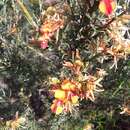mk
имиња во трошки


Jacksonia is a genus of about forty, mostly leafless broom-like shrubs or small trees in the flowering plant family Fabaceae. The genus is endemic to Australia and species occur in a range of habitats in all Australian states except South Australia.
Plants in the genus Jacksonia are mostly leafless shrubs or small trees with rigid branches, and leaves reduced to small scales. The flowers are arranged in spikes or racemes with small bracts or bracteoles. The sepals are joined to form a short tube and the petals are usually shorter than the sepals. The standard or banner petal is circular or kidney-shaped, the wing petals are oblong and the keel petal is more or less straight and wider than the wings.[1]
The genus Jacksonia was first formally described by James Edward Smith from an unpublished manuscript by Robert Brown. Smith's description was published in 1811 in Rees's Cyclopædia along with a description of J. scoparia and J. spinosa. Smith noted that Brown had named the species "in memory of the late Mr. George Jackson, F.L.S., a man of the most excellent and amiable character, devoted to the science of botany". Jackson had died suddenly at the age of 31, in January of the same year.[2][3]
Jacksonia comprises the following species:[4][5][6]
The status of the following species is unresolved:[6][7]
Jacksonia is a genus of about forty, mostly leafless broom-like shrubs or small trees in the flowering plant family Fabaceae. The genus is endemic to Australia and species occur in a range of habitats in all Australian states except South Australia.
Jacksonia es un género de plantas con flores con 89 especies perteneciente a la familia Fabaceae. Es originario de Australia.
Jacksonia es un género de plantas con flores con 89 especies perteneciente a la familia Fabaceae. Es originario de Australia.
Jacksonia est un genre de plantes dicotylédones de la famille des Fabaceae (légumineuses), endémique d'Australie, qui comprend une quarantaine espèces acceptées.
Ce sont des arbrisseaux, des arbustes ou de petits arbres, qui se rencontrent dans les zones arides et semi-arides (quelques espèces dans les zones tropicales) ou dans les forêts sclérophylles, les bois et les landes, souvent sur des arêtes rocheuses ou des pentes montagneuses. Le genre est présent dans tous les États australiens, sauf l'Australie-Méridionale[2].
Selon The Plant List (23 septembre 2018)[3] :
Jacksonia est un genre de plantes dicotylédones de la famille des Fabaceae (légumineuses), endémique d'Australie, qui comprend une quarantaine espèces acceptées.
Ce sont des arbrisseaux, des arbustes ou de petits arbres, qui se rencontrent dans les zones arides et semi-arides (quelques espèces dans les zones tropicales) ou dans les forêts sclérophylles, les bois et les landes, souvent sur des arêtes rocheuses ou des pentes montagneuses. Le genre est présent dans tous les États australiens, sauf l'Australie-Méridionale.
Jacksonia, rod od tridesetak[1] biljnih vrsta iz porodice mahunarki koje rastu po Australiji.
Jacksonia, rod od tridesetak biljnih vrsta iz porodice mahunarki koje rastu po Australiji.
Jacksonia é um género botânico pertencente à família Fabaceae[1].
Jacksonia é um género botânico pertencente à família Fabaceae.
«Jacksonia — World Flora Online». www.worldfloraonline.org. Consultado em 19 de agosto de 2020Jacksonia là một chi gồm một số loài cây bụi không lá thuộc họ Fabaceae, đặc hữu của Úc.